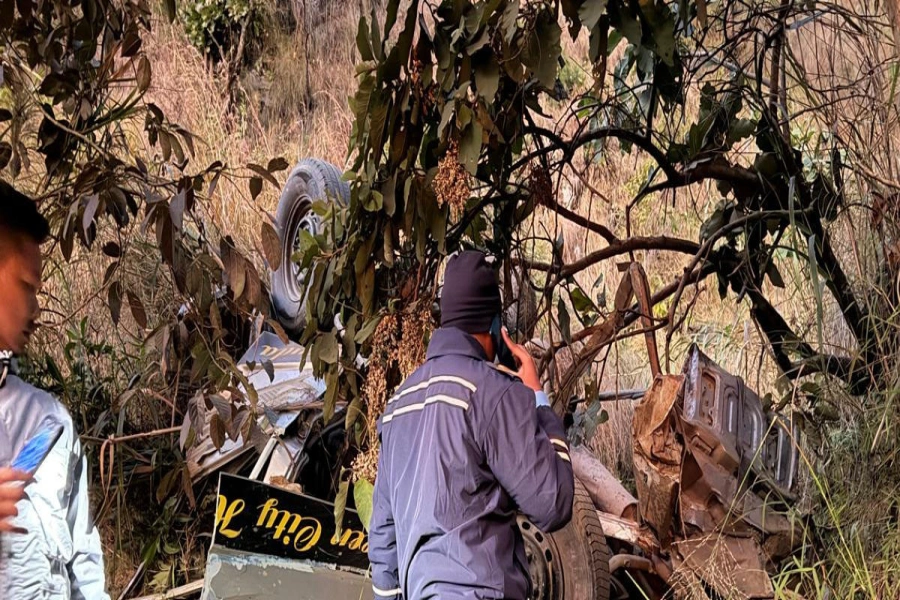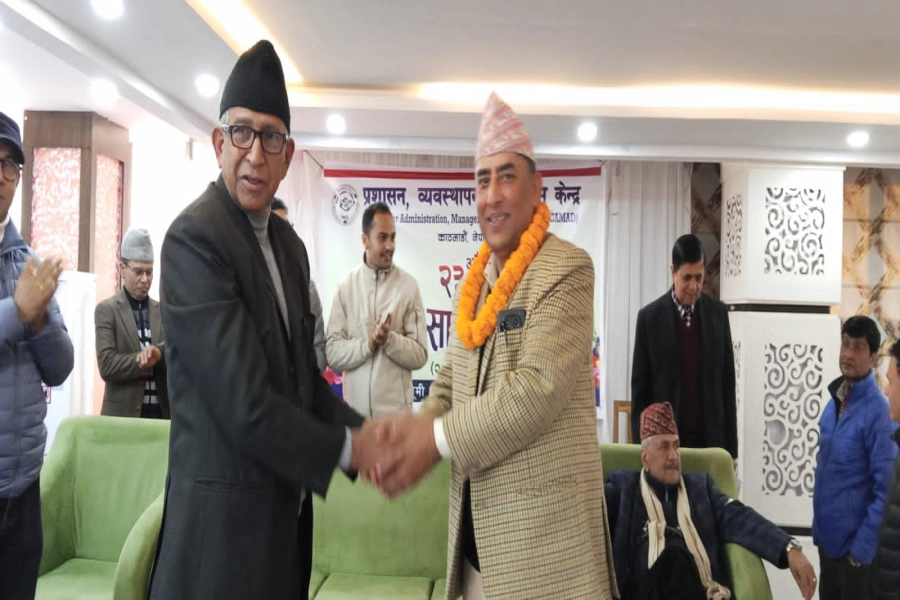The greatest contribution of Naya Raj Pant and his students was awakening their countrymen to the realization that they could carry out research competently enough on their own
Today is the 107th birth anniversary of Naya Raj Pant (1913-2002). It is an opportune moment to recall some of the brilliant deeds spread over his long life.
Naya Raj Pant was born into a family of traditional pandits. His father, Krishna Datta, hailed from Gorkha and was educated in Banaras. He specialized in navya vyakarana, the new stream in the Paninian grammar. After returning to Nepal, he got a job in Kathmandu’s Sanskrit Pathashala as a grammar teacher. He was also reputed for his command over the Bhagavata Purana.
Naya Raj Pant’s mother Yajnapriya was born in a family that had migrated from Gorkha to Kathmandu five generations earlier. Her family was well known as Jyotishi—a traditional combination of mathematician, astronomer and astrologer. Her father Bhuvan Nath Pandey was a teacher of Jyautisha at the Sanskrit Pathashala in Kathmandu. Yajnapriya was Krishna Datta’s second wife, whom he married after the death of his first wife. From his first wife Nanda Kumari, née Tiwari, he had a son named Kashi Prasad.
It seems that Krishna Datta’s life as a teacher in the government school did not pass smoothly. We do not know whether he was relieved from his job or he resigned himself. When his job was terminated he had already three children from his second wife. At this time, he went back to his home in Gorkha, but his wife refused to accompany him and remained in her natal home with her children. After his return to Gorkha, he abruptly died in 1915, at which time Naya Raj Pant was only 18 months old.
Education and scholarship
Naya Raj Pant learned the three Rs (reading, writing and arithmetic) in Kumari Chowk Pathashala, a Nepali medium government school near the Kumari residence in Kathmandu Durbar Square. After finishing, he started privately learning English under a tutor with the aim of enrolling in Durbar High School. He changed his mind, however, and decided to become a jyautisha scholar like many in his maternal family and entered the government Sanskrit pathashala. After spending the required years there he went to Banaras for higher studies. There he was educated at Banaras Sanskrit Pathashala, where he completed his Master’s degree in Indic astronomy. Though he passed all his examinations with distinction, he was utterly dissatisfied with the education that he received.
The British rulers in India, clearly seeing the advantage of ruling the Hindus according to their own laws and customs, encouraged a number of British administrators to study Sanskrit, the main vehicle of Indian thinking for thousands of years. The British government in India needed a continuous flow of native Sanskritists to assist British scholars in acquiring their knowledge. In addition, it wanted to conciliate its Hindu subjects by patronizing their learning and giving them an opportunity to study their own shastras at public expense. To fulfill these goals, it established Sanskrit colleges in different parts of India. The Banaras Sanskrit Pathashala, where Naya Raj Pant studied, was the first of its kind, having been established in 1791 through the efforts of Jonathan Duncan, the then British resident in the court of Banaras, with the intention of patronizing and institutionalizing Sanskrit learning in service of political aims.
Canopy's scholar accepted to NYU Abu Dhabi

Considering that Banaras Pathashala was founded for the reasons stated above, it is not surprising that it made little effort to promote Sanskrit learning in the way with which Sanskrit-educated scholars were traditionally familiar. A serious departure from the traditional standards of scholarship was the introduction of regular examinations in the pathashala. These exams were meant to determine whether or not a student had attained a certain minimum level of academic achievement. Traditional scholarship required one to maintain high level of knowledge acquired as a student throughout one’s active life. Following the new system, however, the student, having once been conferred a degree of permanent value, felt no need to maintain the standards of scholarship so vital for the growth of knowledge and higher pursuits.
Naya Raj Pant was aware of the ongoing study of Sanskrit in the West that started more than three centuries ago. Yet he, likewise, knew the limitations of this kind of study and tried to combine the Western critical approach with the ancient practice of thoroughly mastering texts.
Naya Raj Pant’s disenchantment led him to the realization that traditional scholarship, if properly combined with a critical approach, would offer a better chance of success in Sanskrit studies. He came back home in 1938 and took up the task of teaching students in his own way, which aimed to revive the ancient practice of thoroughly mastering texts and to use the mastery of these texts as a basis for research along the modern lines. He engaged his students year after year in an unparalleled pursuit of knowledge.
Contribution to history
As astronomy is a practical subject, he believed that his new approach could not do much to further knowledge in this field. Instead, he turned his attentions toward the study of Nepali antiquities—a topic which requires a deep knowledge of Sanskrit. He produced scholars of Nepali antiquities and this helped highlight various aspects of Nepali history and gave fresh impetus toward the reconstruction of a correct and complete history of Nepal. The greatest contribution of Naya Raj Pant and his students trained according to the method he developed was to awaken their countrymen to the realization that, given proper education, they could carry out research competently enough on their own. Gone were the days history books would be the summaries of foreign writings.
In order to be convinced of the great strides made in Nepali historiography, one may simply choose any popular book on Nepali history published during the 1950s and compare it with a similar book published later. Much of the credit for this progress doubtlessly must be assigned to Naya Raj Pant and his students, who came to be known as the Samsodhana Mandala group.
Naya Raj Pant’s work challenged the Nepali university system and proved it redundant at least in the study of Nepali antiquities. Not a single epigraphist or iconographer of repute has been produced by the Department of Ancient History in 60 years of its existence. All the scholars working on epigraphy are either Naya Raj Pant’s students or the students of these students.
With the advent of the new methods of study developed by Naya Raj Pant and his students, the bridle of the study of Nepali antiquities passed from foreign scholars’ hands to Nepali hands. In other words, foreign scholars were no longer regarded as the sole authorities in this field, and Naya Raj Pant’s and his students’ research became recognized as authoritative. This changed the academic situation in at least one field and delivered a message of the deliverance from the foreign yoke in education.
Naya Raj Pant’s another outstanding contribution is to the history of Indic mathematics and astronomy. His research proved some theories in these fields were already known to Indian astronomers before their discovery by Western mathematicians and astronomers. He has also contributed to the comparative study of Indic and Greek astronomy. As all his research in this field is published in the Nepali language, they have not attracted much attention of foreign scholarship.
Naya Raj Pant’s knowledge of astronomy also helped to settle the vexing chronology of ancient Nepali history. His research on now-obsolete system of chronometry based on the Jyautisha Vedanga is unparalleled in this field.
In ancient times Indian system of knowledge was segmented into four faculties—Trayi, Anvikshiki, Vartta and Dandaniti. Broadly speaking, Trayi originally meant the collection of the three Vedas—Rigveda, Yajurveda and Samaveda—including the subjects taught under the fold of Humanities. Anvikshiki covers both spiritual and secular systems of philosophy, Vartta is a science that includes agriculture, animal husbandry and commerce and Dandaniti broadly means political science.
In the course of time India was flooded with spiritual ideas and the best minds started concentrating on Anvikshiki ignoring the other faculties. Even in the pursuit of Anvikshiki they did not pay attention to secular systems of philosophy, such as that of the Charvakas. Since Trayi included linguistic study and religious matters too, it somehow maintained a lesser glory. The last two faculties were totally neglected because they had no relevance to spiritual values.
As a result, Kautalya’s Arthashastra, one of the classics produced by the best of Indian minds, was ignored for centuries. It was ‘discovered’ in the last century in South India. Following its publication, generations of Sanskritists engaged themselves in comprehending its contents, though a completely satisfactory understanding is yet to be reached. The reason for this is that the study of Dandaniti was discontinued for an unbelievably long period of time, and its terminologies became incomprehensible. Naya Raj Pant started illuminating some of the obscure passages in Arthashastra and succeeded in this endeavor as well. But his main contribution toward the study of Arthashastra is that he and his students published a series of papers explaining Nepali history in the light of Arthashastra, providing an alternate view to those scholars who interpret history according to different contemporary theories such as those of the Marxist school.
In two ways, Naya Raj Pant was an exception to the pandits that surrounded him. Pandits tend either to be spiritualists or practitioners of elaborate rituals, but he was involved in exact sciences of Sanskrit. Political rationality distinguished him from his colleagues and prompted him to keep journals analyzing political events in Nepal.
Poetic achievements
Though Naya Raj Pant is better known as an astronomer and historian, his poetic achievements, too, are of no less importance. His creative writings both in Nepali and Sanskrit languages are enough to establish him as a writer of considerable merit. Interestingly, he criticized, in the written form, contemporary writers such as Lekhnath Paudyal (1884-1966), Balakrishna Sama (1903-1981) and Laxmi Prasad Devkota (1909-1959) saying that they did not speak up their hearts and instead spent their energies on sycophantic writing inspired by opportunism.
Naya Raj Pant was highly skeptical of foreign scholars working on Indic studies, often thinking that they must have ulterior motives as well. This is why he did not collaborate with them. This conviction was guided by treatises in Indic polity and the lives of some of specific scholars, such as Giuseppe Tucci (1894-1984).
Though Naya Raj Pant started his career being a teacher of Jyautisha in Sanskrit Pathashala and was later promoted to the position of professor at Sanskrit college, his work proceeded without any kind of institutional support. His appointment to the Royal Nepal Academy did little because of various factors involved. Consequently, he became virtually alone and passed his time in solitude. His life seems to me an echo of the following verse of a seventh-century philosopher-poet Dharmakirti:
No one rides before, no one comes behind
and the path bears no fresh prints.
How now, am I alone? Ah yes, I see:
the path which the ancients opened up by now is overgrown
and the other, that broad and easy road, I've surely left.
(Daniel H H Ingalls’ translation)
In conclusion, let me quote Naya Raj Pant’s own Sanskrit verse in which he describes for what he strives:
It is not that I seek mental pleasure,
or that my mind is stupefied by worldly things,
or that I seek to gain friends, land or riches,
or yearn for my own pre-eminence.
That I exert all my strength,
ignoring exorbitant reviling every day,
it is only so that the knowledge
accumulated by my forefathers
may be able to do good for people.
(My translation)
The author is a historian associated
with Samsodhana Mandala




































